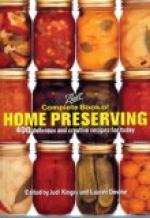THE BEDSTEAD
And now to the piece de resistance of the room, the
“.
. . delicious bed!
That heaven on earth to the weary head!”
Furnished complete it represents a considerable sum, but here again it is well not to count the cost too closely, for the return in comfort and refreshment cannot be estimated in dollars and cents. The change from wooden to metal beds is desirable in every way. Besides being so much more hygienic, they seem to take up less room, and admit of a freer circulation of air; they can be painted over and freshened up when necessary, and look well with any furniture. The best patterns are formed by parallel bars and circles, those with simple lilies conveying the idea of solidity, and with the least ornamentation, being preferable always. The extension foot facilitates the arrangement of spread or valance, and if drapery is desired, beds with head posts fitted with canopy frames or “testers” are to be had. Brass beds are the most expensive of metal beds, costing from $22 to $55, or as much more as one cares to pay. They have to be handled with great care—or rather, not handled at all unless through the medium of a soft cloth. The vernis Martin bed of gilded iron produces the same general effect, and is but little more costly than the enamel bed, but, after all, it is only another “imitation.” Enameled beds can be had for from $2 all the way up to $31. It cannot, of a surety, be necessary to warn against those hideous embodiments of bad taste, colored beds, with their funereal blacks, lurid reds, and sickly blues, greens, and yellows. Enough said! And avoid too much brass trimming. The bed should stand on casters—wooden—and not too high.




